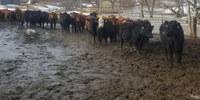Livestock Producers Should Prepare for Flooding
(Click the image below to view a high-resolution image that can be downloaded)
Livestock producers should make plans for moving feed and livestock to higher ground before flooding this spring, North Dakota State University Extension specialists say.
While the latest flood forecast showed some improvements, many areas of North Dakota are projected to experience moderate to major flooding this spring. The greatest flood impacts are expected to be on farms and ranches because of overland flooding. Due to the nature of overland flooding, many areas that typically do not flood may be flooded this year.
“Floodwaters can rise quickly, potentially cutting off access to feed and/or water for livestock,” warns Miranda Meehan, Extension livestock environmental stewardship specialist. “Beef cattle out on pasture are especially susceptible to displacement by flooding.
“Although cattle will move to higher ground if possible, they may move to areas where rescue is not possible,” she adds. “Trying to rescue cattle and other large livestock in deep-water situations is dangerous, and it can be deadly both to animals and people. Plans should be made weeks ahead of a potential disaster, with consideration given to pens, loading facilities, transportation, evacuation routes and final destination of livestock.”
Floodwaters often prevent producers from reaching feed supplies either directly or through damage to roads.
“Having feed supplies on hand is important because feed assistance may not be available during a flood,” says Karl Hoppe, Extension livestock systems specialist based at NDSU’s Carrington Research Extension. “Producers should pre-select sites on high ground for hay, emergency water supplies and fencing supplies or panels.”
Producers also need to be aware that moving feed may cause problems, the specialists say. For example, moving big round hay bales to higher ground can result in hay loss because twine- or net-wrapped bales may be frozen to the ground. Also, road weight restrictions can limit producers’ ability to haul in new feed if they use coproducts such as beet pulp, beet tailings or distillers grains to feed their cattle.
“Producers need to ensure accessible storage facilities and an adequate supply of feedstuffs,” Hoppe says.
While not all areas will experience flooding, mud is likely to be an issue on many farms and ranches this spring.
“Mud can reduce the insulation value of hair coats, increase energy requirements, and increase the potential for footrot and other health issues,” cautions Travis Hoffman, Extension sheep specialist.
Mud also may chill or trap newborn calves and lambs, and can carry a variety of pathogens that can affect calves and lambs directly or through contact with dirty udders.
“There are few options once muddy conditions are in place; therefore, preventive practices are key,” says Janna Block, Extension livestock systems specialist based at NDSU’s Hettinger Research Extension Center.
Here is what the specialists recommend producers to do to lessen muddy conditions:
- Scrape lots to maintain a 3% to 5% slope away from the feed bunk.
- Reshape mounds to ensure quick drainage.
- Move livestock to temporary feeding areas such as stockpiled pastures with adequate drainage or fields containing crop residue such as corn stalks.
“However, utilizing crop residue is not recommended due to the high risk for soil compaction, creating challenging planting conditions,” Meehan says.
“We recommend that producers evaluate their potential for flooding and plan accordingly,” Meehan says. “If you do not have access to higher ground, you may need to consider moving livestock off site until the risk of flooding subsides. If you need help evaluating options, contact your NDSU Extension agent or emergency management office.”
Visit NDSU Extension’s flood website at https://www.ag.ndsu.edu/flood for more information and resources.
NDSU Agriculture Communication - March 9, 2020
| Source: | Janna Block, 701-567-4323, janna.block@ndsu.edu |
|---|---|
| Source: | Travis Hoffman, 701-231-2222, travis.w.hoffman@ndsu.edu |
| Source: | Karl Hoppe, 701-652-2951, karl.hoppe@ndsu.edu |
| Source: | Miranda Meehan, 701-231-7683, miranda.meehan@ndsu.edu |
| Editor: | Ellen Crawford, 701-231-5391, ellen.crawford@ndsu.edu |


